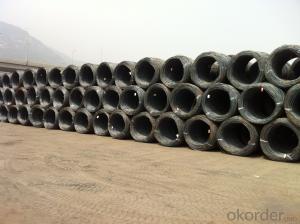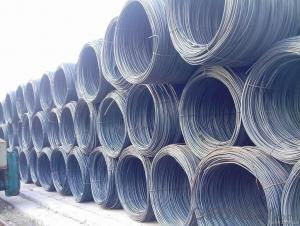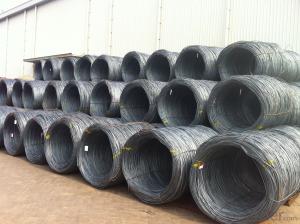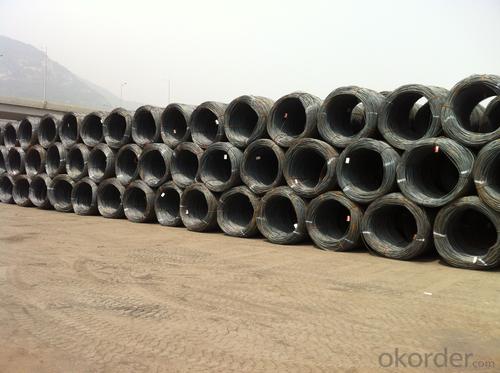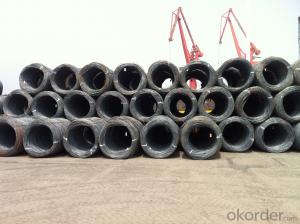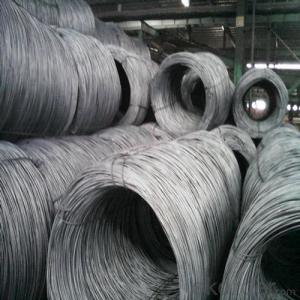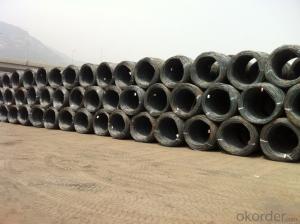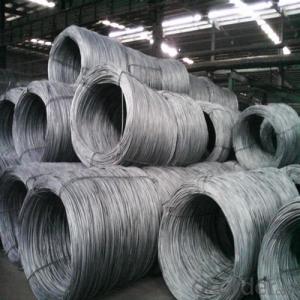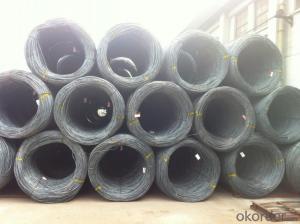Hot Rolled Steel Wire Rods with Grade ASTM SAE1008
- Loading Port:
- Tianjin
- Payment Terms:
- TT OR LC
- Min Order Qty:
- 25 m.t
- Supply Capability:
- 20000 m.t/month
OKorder Service Pledge
OKorder Financial Service
You Might Also Like
Specification
OKorder is offering Hot Rolled Carbon Steel Wire Rod 5.5mm with High Quality at great prices with worldwide shipping. Our supplier is a world-class manufacturer of steel, with our products utilized the world over. OKorder annually supplies products to European, North American and Asian markets. We provide quotations within 24 hours of receiving an inquiry and guarantee competitive prices.
Product Applications:
Hot Rolled Carbon Steel Wire Rod 5.5mm with High Quality is widely used in construction and manufacturing. Carbon steel wire rod is mainly used for reinforcement of reinforced concrete and welded structure or reprocessed (roberts , nail, etc.) materials, especially used to produce wire drawing, welding electrode, nails, spring, electronic, precise machinery parts and so on.
Product Advantages:
OKorder's Hot Rolled Carbon Steel Wire Rod 5.5mm with High Quality are durable, strong.packed and suitable for wire mesh,nail manufacture and construction
Main Product Features:
· Premium quality
· Prompt delivery & seaworthy packing (30 days after receiving deposit)
· Can be recycled and reused
· Mill test certification
· Professional Service
· Competitive pricing
Product Specifications:
Manufacture: Hot rolled
Grade: SAE1006 SAE1008 SAE1010 SAE1012 SAE1016 SAE1018
Certificates: ISO, SGS, BV, CIQ
Weight per Coil:2-2.05tons
Packaging: Export packing, packed by coil
Grade | Chemical Composition (%) | |||||
C | Mn | S | P | Si | B | |
SAE1006B | 0.03~O.07 | 0.32max | 0.045max | 0.040max | 0.30max | 0.0008min |
Mechanical properties | ||||||
Yield strength(N/mm2) | Tensile strength(N/mm2) | Elongation (%) | ||||
250-280 | 350-380 | ≥32 | ||||
Grade | Chemical Composition (%) | |||||
C | Mn | S | P | Si | B | |
SAE1008B | 0.10max | 0.3~0.50 | 0.050max | 0.040 max | 0.15max | 0.0008 min |
Mechanical properties | ||||||
Yield strength(N/mm2) | Tensile strength(N/mm2) | Elongation (%) | ||||
≥195 | 315-430 | ≥30 | ||||
FAQ:
Q1: Why buy Materials & Equipment from OKorder.com?
A1: All products offered byOKorder.com are carefully selected from China's most reliable manufacturing enterprises. Through its ISO certifications, OKorder.com adheres to the highest standards and a commitment to supply chain safety and customer satisfaction.
Q2: How do we guarantee the quality of our products?
A2: We have established an advanced quality management system which conducts strict quality tests at every step, from raw materials to the final product. At the same time, we provide extensive follow-up service assurances as required.
Q3: How many tons can be loaded into one 20ft container?
A3: Around 18—20tons,9-10 coils.
Image:
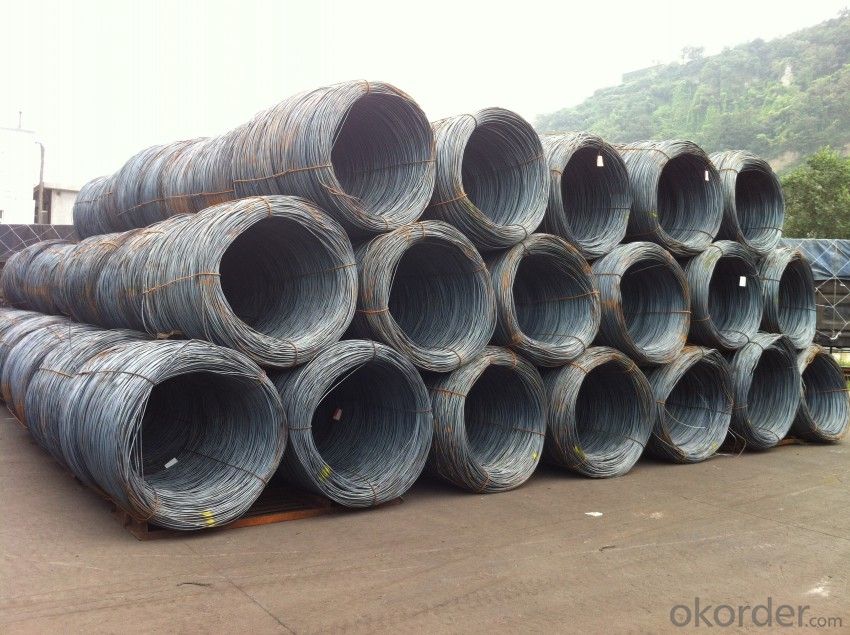
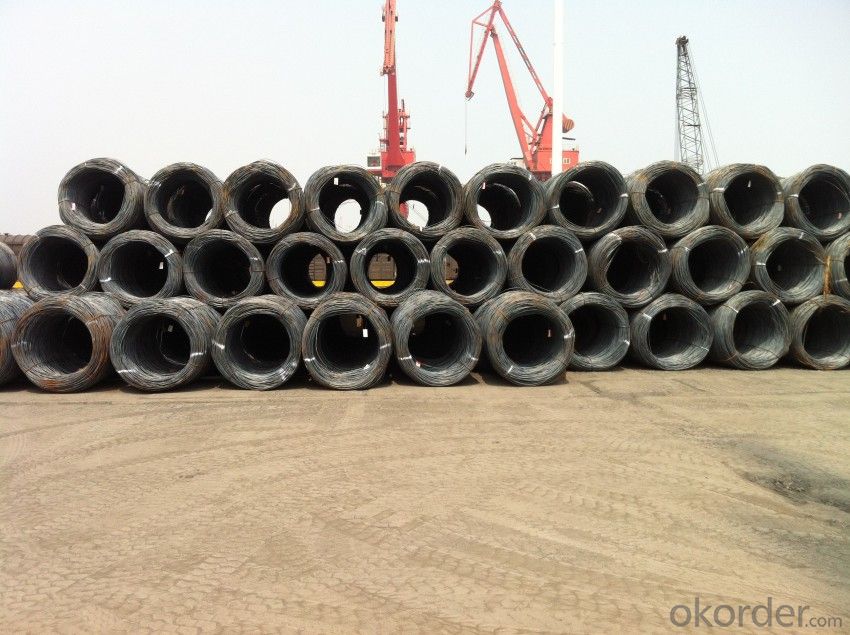
- Q: What are the main factors affecting the thermal conductivity of steel wire rod?
- The main factors affecting the thermal conductivity of steel wire rod are its chemical composition, microstructure, and temperature. The presence of alloying elements, such as carbon, manganese, and silicon, can significantly influence the thermal conductivity. Additionally, the microstructure of the steel, including grain size and the presence of impurities or defects, can also impact thermal conductivity. Lastly, temperature plays a crucial role as higher temperatures tend to increase thermal conductivity due to increased atomic vibrations.
- Q: What are the different types of steel wire rod coatings used for improved ductility?
- Enhancing ductility in steel wire rods involves the utilization of various coatings. These coatings are applied to the surface of the wire rod, serving as a protective layer and improving its mechanical properties. Commonly used coatings include: 1. Zinc Coating: Zinc coatings are extensively utilized for steel wire rods due to their exceptional corrosion resistance and ability to enhance ductility by minimizing the formation of brittle intermetallic compounds. Hot-dip galvanizing, the most prevalent method, involves immersing the wire rod in molten zinc. 2. Copper Coating: Copper coatings are often combined with zinc coatings to provide additional protection against corrosion. Copper aids in enhancing ductility by reducing the formation of brittle phases and improving the wire rod's resistance to cracking during deformation. 3. Phosphate Coating: Steel wire rods are treated with phosphate coatings to enhance lubricity and reduce friction during drawing and forming processes. Moreover, these coatings enhance adhesion between the wire rod and subsequent coatings like zinc or copper. 4. Polymer Coating: Polymer coatings, such as epoxy or polyvinyl chloride (PVC), are employed to establish a protective layer against corrosion and enhance ductility. These coatings function as a barrier, preventing moisture and corrosive substances from penetrating the wire rod and its surroundings. 5. Chromium Coating: Chromium coatings are commonly utilized in high-strength steel wire rods to enhance ductility and minimize the risk of hydrogen embrittlement. These coatings bolster the wire rod's resistance to cracking, thereby enhancing its mechanical properties. It is important to consider that the choice of coating depends on the specific application and desired properties of the steel wire rod. Different coatings offer varying levels of corrosion resistance, lubricity, and adhesion, allowing customization to meet the requirements of diverse industries and applications.
- Q: How is steel wire rod tested for chemical composition?
- Steel wire rod is typically tested for chemical composition through a process called spectroscopy. This involves using specialized equipment to analyze the elemental composition of the steel wire rod by measuring the wavelengths of light emitted or absorbed by the different elements present in the sample. By comparing these measurements to known standards, the exact chemical composition of the steel wire rod can be determined accurately.
- Q: What are the main factors influencing the choice of steel wire rod order invoicing process?
- The main factors influencing the choice of steel wire rod order invoicing process are efficiency, accuracy, and customer preference. Efficiency is a crucial factor as it directly impacts the time and resources required to process and generate invoices for steel wire rod orders. Companies in the steel industry need to consider the speed and automation of the invoicing process to ensure timely and seamless delivery of invoices to customers. This may involve using software or systems that can automatically generate invoices based on order details, reducing the need for manual data entry and minimizing the chances of errors or delays. Accuracy is another important factor as it ensures that the invoices accurately reflect the quantities, prices, and terms agreed upon in the order. Invoices that are incorrect or contain discrepancies can lead to disputes and delays in payment processing. Therefore, the invoicing process should incorporate mechanisms to verify and cross-check the order details to maintain accuracy. Customer preference also plays a significant role in determining the invoicing process. Different customers may have different requirements or preferences for how they receive and process invoices. Some may prefer digital invoices sent via email or electronic data interchange (EDI), while others may still prefer physical copies sent through mail or courier. Companies need to understand and accommodate these preferences to ensure customer satisfaction and facilitate smooth payment processing. Additionally, factors such as regulatory compliance, data security, and integration with existing systems may also influence the choice of steel wire rod order invoicing process. Companies need to adhere to legal and regulatory requirements related to invoicing and ensure the security and privacy of customer data. Integration with existing systems, such as enterprise resource planning (ERP) or customer relationship management (CRM) software, can also streamline the invoicing process and enhance overall efficiency. In conclusion, the main factors influencing the choice of steel wire rod order invoicing process are efficiency, accuracy, and customer preference. Companies need to consider these factors and select a process that optimizes these aspects while ensuring compliance and data security.
- Q: What are the different types of steel wire rod coatings used for corrosion resistance?
- For corrosion resistance, various types of coatings are commonly utilized on steel wire rods. These coatings serve as a protective barrier against moisture and chemicals that may cause corrosion. The most commonly employed coatings include: 1. Zinc Coating: Widely used, the zinc coating, known as galvanization, involves applying a layer of zinc to the wire rod's surface. By acting as a sacrificial anode, the zinc corrodes before the steel wire rod, thus safeguarding it against corrosion. 2. Epoxy Coating: Epoxy coatings are ideal for steel wire rods exposed to harsh environments or chemicals. These coatings offer exceptional corrosion resistance and can endure high temperatures. The application of epoxy coatings usually involves electrostatic spray deposition. 3. Polymer Coating: Polymer coatings are a popular choice for corrosion resistance. They are typically crafted from thermoplastic or thermosetting materials and can be applied through dipping, spraying, or extrusion. Polymer coatings create a durable and flexible barrier against moisture and chemicals. 4. Ceramic Coating: Ceramic coatings are suitable for steel wire rods exposed to extreme temperatures or abrasive environments. These coatings provide excellent corrosion resistance, as well as high thermal and chemical stability. Ceramic coatings are typically applied using thermal spraying. 5. Phosphate Coating: Phosphate coatings are frequently used as a pre-treatment for steel wire rods before applying other protective coatings. These coatings form a thin layer of phosphate on the wire rod's surface, enhancing adhesion and corrosion resistance of subsequent coatings. Ultimately, the selection of a steel wire rod coating depends on the specific application and desired level of corrosion resistance. Each type of coating offers distinct advantages and can be customized to meet the wire rod's specific requirements.
- Q: What are the factors that influence the mechanical properties of steel wire rod?
- The mechanical properties of steel wire rods can be influenced by several factors. These factors encompass: 1. Composition: The mechanical properties of steel are determined by its chemical composition, including the presence of alloying elements. Alloying elements like carbon, manganese, silicon, and others can affect the wire rod's strength, hardness, and ductility. 2. Microstructure: The mechanical properties of steel are greatly influenced by its microstructure, which is determined by factors like cooling rate and heat treatment. The arrangement of grains, impurity presence, and size and distribution of precipitates can all impact the wire rod's strength, toughness, and other properties. 3. Processing conditions: During the production of wire rods, the mechanical properties can be significantly affected by processing conditions such as temperature, cooling rate, and rolling conditions. Controlled cooling rates, for example, can result in a fine-grained microstructure that enhances the wire rod's strength and toughness. 4. Heat treatment: Heat treatment processes like annealing, quenching, and tempering can further modify the mechanical properties of steel wire rods. These processes refine the microstructure, relieve internal stresses, and improve the wire rod's strength, hardness, and ductility. 5. Surface finish: The mechanical properties of the wire rod can also be influenced by its surface finish, including factors like scale, decarburization, and surface defects. A smooth and clean surface contributes to better fatigue resistance and overall mechanical performance. 6. Size and shape: The mechanical properties of wire rods can be influenced by their size and shape, including diameter and cross-sectional profile. Thicker rods tend to have higher strength but lower ductility, while thinner rods may exhibit higher ductility but lower strength. 7. Environmental conditions: The mechanical properties of steel wire rods can also be affected by environmental conditions in which they are used. Factors like temperature, humidity, and exposure to corrosive substances can impact the wire rod's strength, toughness, and corrosion resistance. Considering these factors is crucial when selecting or designing steel wire rods for specific applications, as they greatly impact the performance and reliability of the final product.
- Q: How is steel wire rod used in the manufacturing of wire for suspension bridges?
- Steel wire rod is a crucial component in the manufacturing of wire for suspension bridges. The wire rod is first produced by a steel mill through a process called hot rolling, where the steel is heated and then passed through a series of rollers to shape it into a long, continuous rod. This rod is then cooled and cut into shorter lengths, which are further processed to make wire for suspension bridges. In the manufacturing process, the steel wire rod is first cleaned and coated with a protective layer to prevent corrosion. It is then drawn through a series of dies, which gradually reduce the diameter of the wire while increasing its length. This drawing process strengthens the wire and increases its tensile strength, making it suitable for use in suspension bridges. Once the wire is drawn to the desired size, it is further processed to meet the specific requirements of suspension bridge construction. This may involve heat treatment to enhance its mechanical properties, such as increasing its resistance to fatigue and improving its flexibility. The wire is then spooled onto large reels, ready to be transported to the construction site. At the site, the wire is unwound from the reels and used to form the main cables of the suspension bridge. These cables are typically composed of multiple strands of steel wire twisted together to provide the necessary strength and stability. The steel wire rod used in the manufacturing of wire for suspension bridges is specifically chosen for its high strength, durability, and resistance to environmental factors such as corrosion. It undergoes rigorous testing and quality control measures to ensure it meets the required specifications and standards. Overall, steel wire rod plays a critical role in the construction of suspension bridges by providing the necessary strength and stability to support the weight of the bridge and withstand external forces. Its use in suspension bridge construction is essential for ensuring the safety and longevity of these structures.
- Q: What are the main factors influencing the choice of steel wire rod order payment refund options?
- The main factors influencing the choice of steel wire rod order payment refund options can vary depending on various factors. However, some common factors that play a significant role in this decision-making process include: 1. Supplier Reputation: The reputation and trustworthiness of the supplier is a crucial factor. Buyers tend to choose payment refund options that provide them with a sense of security in case of any issues or disputes with the supplier. 2. Order Volume and Value: The size and value of the steel wire rod order can impact the choice of payment refund options. Larger orders with higher values may require more secure refund options to mitigate potential financial risks. 3. Payment Terms and Conditions: The payment terms and conditions set by the supplier can influence the choice of refund options. Some suppliers may offer specific refund options based on their preferred payment methods, such as bank transfers, letters of credit, or escrow services. 4. Buyer's Financial Capability: The financial capability of the buyer can also determine the choice of refund options. Buyers with limited financial resources may opt for payment refund options that offer flexibility and minimize risks, such as installment payments or delayed payment terms. 5. Delivery and Quality Assurance: The reliability and quality assurance provided by the supplier can impact the choice of refund options. Buyers may prefer refund options that allow them to inspect the steel wire rod upon delivery and ensure compliance with the agreed specifications before making full payment. 6. Market Conditions and Competition: Market conditions and competition among suppliers can influence the choice of refund options. Buyers may consider refund options that are more favorable or competitive in the market, such as cash discounts or rebates. 7. Legal and Regulatory Considerations: Legal and regulatory requirements in the buyer's jurisdiction can also affect the choice of refund options. Buyers may opt for refund options that comply with local regulations and provide legal protection in case of any disputes or non-compliance. It is important for buyers to carefully evaluate these factors and assess their specific needs and preferences before deciding on the most suitable payment refund options for their steel wire rod orders.
- Q: What are the different types of steel wire rod surface defect measurement devices?
- There are several types of steel wire rod surface defect measurement devices available in the market. Some common ones include optical inspection systems, laser scanning systems, and electromagnetic induction systems. These devices use various techniques such as image processing, laser triangulation, and magnetic field analysis to detect and measure surface defects on steel wire rods.
- Q: What are the common manufacturing processes for steel wire rod?
- The common manufacturing processes for steel wire rod include hot rolling, cold drawing, and annealing.
Send your message to us
Hot Rolled Steel Wire Rods with Grade ASTM SAE1008
- Loading Port:
- Tianjin
- Payment Terms:
- TT OR LC
- Min Order Qty:
- 25 m.t
- Supply Capability:
- 20000 m.t/month
OKorder Service Pledge
OKorder Financial Service
Similar products
Hot products
Hot Searches
Related keywords
